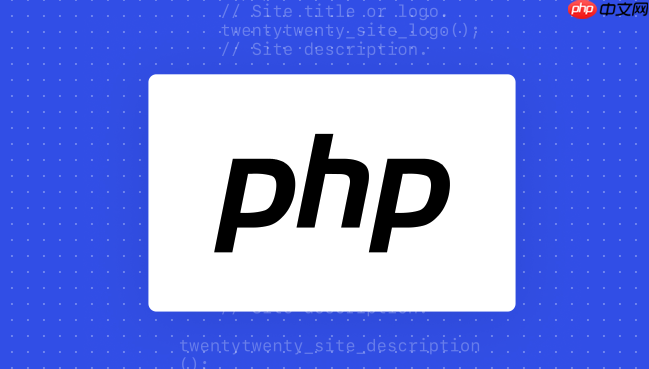 Backend Development
Backend Development
 PHP Tutorial
PHP Tutorial
 How to develop AI-based text summary with PHP Quick Refining Technology
How to develop AI-based text summary with PHP Quick Refining Technology
How to develop AI-based text summary with PHP Quick Refining Technology
Jul 25, 2025 pm 05:57 PMThe core of PHP's development of AI text summary is to call external AI service APIs (such as OpenAI, Hugging Face) as a coordinator to realize text preprocessing, API requests, response analysis and result display; 2. The limitation is that the computing performance is weak and the AI ecosystem is weak. The response strategy is to leverage APIs, service decoupling and asynchronous processing; 3. Model selection requires weighing the summary quality, cost, delay, concurrency, data privacy, and abstract models such as GPT or BART/T5 are recommended; 4. Performance optimization includes cache, asynchronous queues, batch processing and nearby area selection. Error processing needs to cover current limit retry, network timeout, key security, input verification and logging to ensure the stable and efficient operation of the system.

The core of developing AI-based text summary with PHP is to connect PHP as a front-end or back-end coordinator to powerful AI model services (whether it is a cloud API or local deployment). PHP itself is not good at complex AI model training or inference, but it performs well in data processing, API calls and result presentation, and is ideal for quickly building such applications.

Solution
To implement AI-based text summary, PHP's strategy is usually to leverage external AI services or communicate with local AI models. The most direct and most efficient way is to access the APIs of mature AI service providers, such as OpenAI, Google Cloud AI, or Hugging Face APIs.
A common process is:

- Text input and preprocessing : Users submit text through PHP applications, and PHP cleanses and formats the text as necessary, such as removing unnecessary spaces, HTML tags, etc.
- API call : PHP uses an HTTP client (such as Guzzle or native
curl) to send a request to the digest API of the AI service, which contains the text to be digested and related parameters (such as digest length, type, etc.). - Receive and parse responses : The AI service processes text and returns summary results, usually in JSON format. PHP parses JSON response and extracts the summary content.
- Results display : PHP presents the summary results to the user.
The advantages of this approach are obvious: you don't need to care about the complex machine learning models at the bottom, you just need to focus on PHP application logic. For the requirement of "fast information refinement", API calls are the fastest path, because the calculations of the model are all completed in the cloud.
Of course, for the sake of data privacy or extreme performance optimization, you can also deploy local AI models on the server (usually built with Python frameworks such as PyTorch or TensorFlow), and then let PHP call these models through process communication ( shell_exec calls Python scripts) or internal HTTP services (Python's Flask/FastAPI provides API interfaces). However, this can significantly increase the complexity of deployment and maintenance.

Limitations and coping strategies of PHP in text summary
To be honest, PHP itself is not a language created for deep learning. It is far less efficient than Python, Java or C in handling a large number of parallel computing or complex matrix operations. Therefore, it is unrealistic and completely unnecessary to rely on PHP to directly train a Transformer model from scratch. It's like you won't use a screwdriver to build a house, it has its own place to use it.
The main limitations of PHP are:
- Computation-intensive tasks : both inference and training of AI models require a large amount of computing resources, and PHP is not a strong point in this regard.
- Ecosystem : Almost all mainstream libraries and frameworks in the AI/ML field are built around Python, and PHP has a very weak ecosystem in this regard.
But these limitations do not mean that PHP cannot participate in AI projects. The response strategy is to "leverage the strength to fight the strength":
- Embrace API : This is the smartest and most practical approach. With powerful APIs provided by OpenAI, Anthropic, Hugging Face, etc., they have helped you get the most complex parts done. PHP only needs to be responsible for data transmission and result parsing. This greatly reduces development threshold and time costs, and is particularly suitable for rapid prototyping and deployment.
- Service decoupling : If a local model is needed, the AI model can be deployed independently as a microservice (for example, built with Python Flask), and PHP communicates with this microservice via HTTP requests. In this way, the performance bottlenecks and dependencies of the AI part are separated from PHP applications, making it easy to maintain and expand.
- Asynchronous processing : Text summary may take a certain amount of time. In order to avoid blocking the user interface, you can consider putting the summary request into a message queue (such as RabbitMQ, Redis Streams), and processing it asynchronously by the background worker process (managed by PHP CLI or Supervisor). After the processing is completed, the user will be notified or updated.
Selecting the right AI model for consideration of PHP text summary
Choosing an AI model is actually choosing a "brain" to help you understand and summarize the text. It depends on your specific needs and budget. There are many types of models on the market, which can be roughly divided into two categories:
- Extractive Summarization : This model "extracts" the most important sentences or phrases from the original text and then splices them together to form an abstract. The advantage is that the accuracy of the original text is retained, without illusions (i.e., the model fabricates information that does not exist), and the implementation is relatively simple. The disadvantage is that it may not be smooth enough, or it cannot summarize the deep meaning that is not directly expressed in the original text.
- Abstract Summary : This model is more advanced. It can "understand" the original text like a human, and then reorganize and generate the abstract in its own language, and even introduce words or concepts that are not in the original text. The advantage is that the summary is smoother, more natural, and more generalized. The disadvantage is that the model is more complex, the training is difficult, and there is a risk of "illusion" (i.e., generating inaccurate or false information).
For PHP applications, you usually don't directly select and train a model, but choose a service provider. Considerations include:
- Summary Quality : This is the most important. Different models may vary greatly in the effect of abstracts of different types of text (news, papers, conversations, etc.). It is best to use your actual data samples for testing.
- Cost : API calls are usually billed by word count or requests, and large models (such as GPT-4) are more expensive. For large amounts of text processing, the cost is a big problem.
- Latency : The time it takes from sending a request to receiving a digest. For real-time applications, low latency is crucial.
- Concurrency capability : Can the API service handle your high concurrent request volume?
- Data Privacy and Security : If sensitive data is processed, it is necessary to confirm the service provider's data processing policy.
- Model size and complexity : If you choose local deployment, the larger the model, the higher the server resource requirements.
Currently, some pre-trained models on Hugging Face (such as BART, T5) are good choices. They do a great job of abstract abstractions, producing high-quality, smooth summary.
Performance optimization and error handling of PHP text summary application
Any application development, performance and robustness are unavoidable topics. This is especially important for PHP-driven AI text summary, because you rely on external services, network latency, API current limit, and service interruptions may occur.
Performance optimization:
- Caching mechanism : This is the most direct and effective optimization method. For duplicate text summary requests, or text whose digest results do not change frequently, the digest results can be cached (for example, using Redis, Memcached, or file cache). The next time you request the same text, get it directly from the cache to avoid unnecessary API calls. This not only improves the response speed, but also saves API call costs.
- Asynchronous processing and queueing : If your application needs to process large amounts of text or digest requests, calling the API synchronously may cause the user to wait too long. Put the digest task into the message queue (such as RabbitMQ, Redis Streams) and is processed asynchronously by the background consumer process. When the digest is completed, the user is notified via WebSocket, WebHook or polling. This can significantly improve user experience and system throughput.
- Batch processing : Some AI service APIs support batch text summary. If possible, merge multiple small texts into one request and send them to the API, which can reduce the number of network round trips and improve efficiency. Of course, be aware of the API's limit on the text size of a single request.
- Select the nearest API area : If the AI service provider has multiple data centers, selecting the closest area to your server or user can reduce network latency.
Error handling:
- API current limiting : AI services usually have API call frequency limits. When the limit is reached, the API returns a specific error code. Your PHP application needs to catch these errors and implement an Exponential Backoff retry mechanism, that is, wait longer for each retry to avoid triggering current limits immediately.
- Network Errors and Timeouts : Network instability may cause request failure or timeout. Set a reasonable HTTP request timeout time and catch network exceptions. A limited number of retrys can be performed when the request fails.
- API Key Management : API Keys are sensitive information and should not be hardcoded in code. Use environment variables or specialized key management services to store and load. If the key is leaked, it should be revoked and replaced immediately.
- Input Verification and Sanitization : Be sure to perform strict verification and cleaning before sending the text entered by the user to the AI service. For example, limit text length, remove potential malicious code or unnecessary characters. Too large text can cause API requests to fail or over-expense.
- Model Errors and Exceptions : AI models may return erroneous or undesirable results when processing certain special texts. Your application needs to be able to identify these situations and give friendly prompts, or have alternatives (for example, if the summary fails, display the original text).
- Logging : Record API requests, responses, errors, and performance data in detail. This is crucial for debugging problems, monitoring system health, and analyzing user behavior.
The above is the detailed content of How to develop AI-based text summary with PHP Quick Refining Technology. For more information, please follow other related articles on the PHP Chinese website!

Hot AI Tools

Undress AI Tool
Undress images for free

Undresser.AI Undress
AI-powered app for creating realistic nude photos

AI Clothes Remover
Online AI tool for removing clothes from photos.

ArtGPT
AI image generator for creative art from text prompts.

Stock Market GPT
AI powered investment research for smarter decisions

Hot Article

Hot Tools

Notepad++7.3.1
Easy-to-use and free code editor

SublimeText3 Chinese version
Chinese version, very easy to use

Zend Studio 13.0.1
Powerful PHP integrated development environment

Dreamweaver CS6
Visual web development tools

SublimeText3 Mac version
God-level code editing software (SublimeText3)
 Safari Online Browsing Safari Quick Access
Oct 14, 2025 am 10:27 AM
Safari Online Browsing Safari Quick Access
Oct 14, 2025 am 10:27 AM
The quick access portal to Safari is https://www.apple.com/safari/. Its interface adopts a minimalist design, with clear functional partitions. It supports switching between dark and light color modes, and the sidebar can be customized for frequently used websites. It has performance advantages such as fast web page loading, low memory usage, full support for HTML5, and intelligent anti-tracking. Data such as bookmarks, history, and tag groups are synchronized across devices through Apple ID, iCloud keychain synchronization passwords, Handoff relay browsing, and multi-end sharing in reader mode.
 How to work with multibyte (UTF-8) strings in PHP
Oct 12, 2025 am 03:55 AM
How to work with multibyte (UTF-8) strings in PHP
Oct 12, 2025 am 03:55 AM
Usembstringfunctionslikemb_strlen()andmb_substr()insteadofstrlen()orsubstr()tocorrectlyhandleUTF-8strings,asstandardfunctionscountbytesratherthancharacters,leadingtoerrorswithmultibytetextsuchas'café'orChinesecharacters.
 How to initialize a static member in a class in C
Oct 15, 2025 am 02:31 AM
How to initialize a static member in a class in C
Oct 15, 2025 am 02:31 AM
Static members belong to classes rather than objects and need to be initialized outside the class. Use the static keyword when declaring, and initialize it in the global scope outside the class in the form of "class name::variable name=value" when defining, and access it through the class name and scope operator.
 What should I do if the web text highlighting function of Google Chrome cannot be used?
Oct 13, 2025 am 10:58 AM
What should I do if the web text highlighting function of Google Chrome cannot be used?
Oct 13, 2025 am 10:58 AM
Chrome 131 version has a known bug in which text highlighting fails. It mainly affects websites that use TailwindCSS. It can be solved by updating to version 131.0.6778.86 or above and restarting the browser. If the problem still exists, you need to troubleshoot extensions or website style conflicts. If necessary, clear browsing data or check theme settings.
 How to use cin to get input in C
Oct 15, 2025 am 03:39 AM
How to use cin to get input in C
Oct 15, 2025 am 03:39 AM
Use cin to obtain input from the user. It must include a header file and read data into variables using the >> operator. It supports input of multiple data types.
 What is late static binding in PHP
Oct 13, 2025 am 05:12 AM
What is late static binding in PHP
Oct 13, 2025 am 05:12 AM
Latestaticbindingallowsstatic::toreferencethecalledclassatruntime.Unlikeself::,whichbindsearlytothedefiningclass,static::enablesChildClass::test()tocallitsownwho()method,makinginheritedstaticmethodsbehavemoreintuitivelylikeinstancemethodsinPHP.
 How to use the final keyword for classes and methods in PHP
Oct 14, 2025 am 04:53 AM
How to use the final keyword for classes and methods in PHP
Oct 14, 2025 am 04:53 AM
ThefinalkeywordinPHPpreventsinheritanceandmethodoverridingtoenforcedesignintegrity.2.Afinalclasscannotbeextended,ensuringitslogicremainsunchanged.3.Finalmethodscannotbeoverridden,preservingcorebehaviorinchildclasses.4.Usefinaljudiciouslyonclassesorme
 How to add frequently used websites to favorites in safari browser_Add frequently used websites to favorites in safari browser
Oct 14, 2025 am 10:33 AM
How to add frequently used websites to favorites in safari browser_Add frequently used websites to favorites in safari browser
Oct 14, 2025 am 10:33 AM
First, you can quickly add a website by dragging the address bar icon to the favorites bar. Second, use "Bookmarks > Add Bookmark" to customize the save location. Furthermore, it supports importing HTML bookmark files to add in batches. Finally, you can retrieve and add missing websites from the history.



